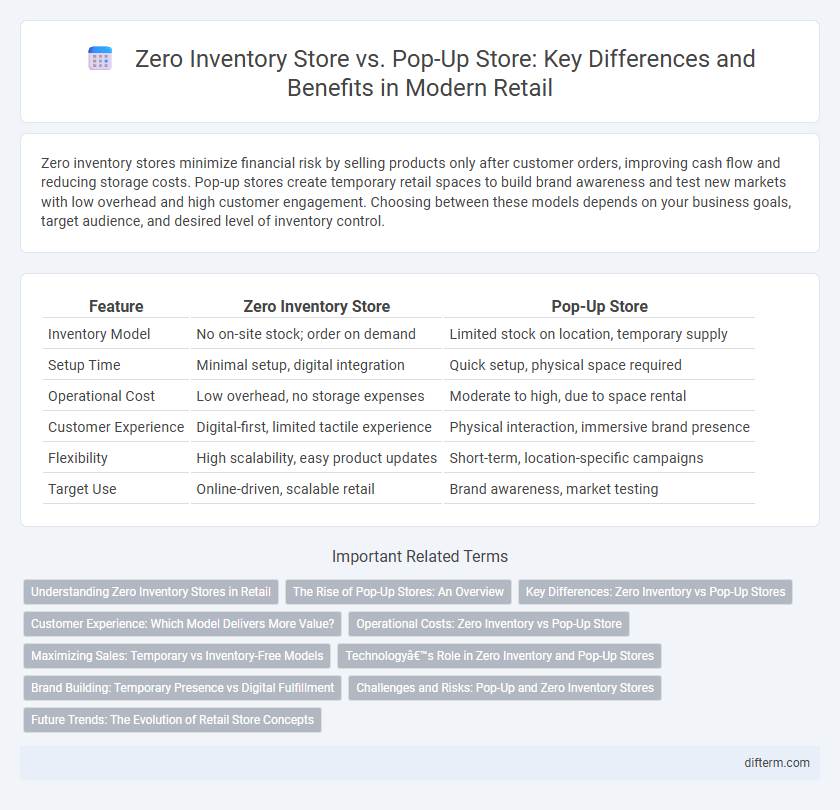Zero inventory stores minimize financial risk by selling products only after customer orders, improving cash flow and reducing storage costs. Pop-up stores create temporary retail spaces to build brand awareness and test new markets with low overhead and high customer engagement. Choosing between these models depends on your business goals, target audience, and desired level of inventory control.
Table of Comparison
| Feature | Zero Inventory Store | Pop-Up Store |
|---|---|---|
| Inventory Model | No on-site stock; order on demand | Limited stock on location, temporary supply |
| Setup Time | Minimal setup, digital integration | Quick setup, physical space required |
| Operational Cost | Low overhead, no storage expenses | Moderate to high, due to space rental |
| Customer Experience | Digital-first, limited tactile experience | Physical interaction, immersive brand presence |
| Flexibility | High scalability, easy product updates | Short-term, location-specific campaigns |
| Target Use | Online-driven, scalable retail | Brand awareness, market testing |
Understanding Zero Inventory Stores in Retail
Zero inventory stores in retail operate by leveraging direct supplier relationships and just-in-time logistics to fulfill customer orders without holding physical stock onsite. This model minimizes overhead costs and reduces risks associated with unsold merchandise compared to traditional pop-up stores, which temporarily stock inventory for short-term sales events. Emphasizing digital integration and efficient supply chain management, zero inventory stores enhance customer experience through broader product availability and faster delivery times.
The Rise of Pop-Up Stores: An Overview
Pop-up stores have surged in popularity within the retail sector due to their ability to create immersive, time-limited shopping experiences that drive consumer engagement and brand awareness. Unlike zero inventory stores, which focus solely on digital transactions without physical stock, pop-up stores provide tangible interaction with products, fostering immediate customer feedback and impulse purchases. Retailers leverage pop-up shops for market testing, seasonal campaigns, and expanding reach without long-term lease commitments, making them a dynamic addition to omnichannel strategies.
Key Differences: Zero Inventory vs Pop-Up Stores
Zero inventory stores operate without holding physical stock, relying on direct supplier shipments to fulfill orders instantly, minimizing overhead and inventory risks. Pop-up stores function as temporary retail spaces with physical inventory, designed to generate buzz and test markets within limited timeframes. Key differences include the inventory handling approach--zero inventory stores emphasize just-in-time fulfillment, while pop-up stores manage tangible stock on-site for immediate customer purchase.
Customer Experience: Which Model Delivers More Value?
Zero inventory stores enhance customer experience by offering a seamless, on-demand purchasing process with real-time product customization and immediate access to extensive online catalogs. Pop-up stores create unique, immersive brand interactions that drive excitement and exclusivity through temporary, physical presence in high-traffic locations. The zero inventory model excels in convenience and variety, while pop-up stores deliver memorable, tactile experiences that foster stronger emotional connections.
Operational Costs: Zero Inventory vs Pop-Up Store
Zero Inventory Stores minimize operational costs by eliminating inventory holding expenses, reducing warehouse space needs, and lowering the risk of unsold stock. Pop-Up Stores incur moderate operational costs, including short-term lease fees, setup expenses, and staffing, but typically avoid long-term commitments and excess inventory costs. Retailers leverage Zero Inventory Stores for cost efficiency and Pop-Up Stores for flexible market testing without substantial upfront investment.
Maximizing Sales: Temporary vs Inventory-Free Models
Zero inventory stores maximize sales by leveraging just-in-time fulfillment and digital catalogs, eliminating storage costs and reducing overstock risks. Pop-up stores drive urgency and exclusivity through limited-time physical presence, attracting foot traffic and immediate purchases. Both models optimize retail strategies by balancing risk management with consumer engagement to boost revenue efficiently.
Technology’s Role in Zero Inventory and Pop-Up Stores
Technology enables zero inventory stores to operate efficiently by leveraging real-time data analytics, automated supply chain management, and AI-driven demand forecasting, minimizing overstock and stockouts. Pop-up stores benefit from mobile point-of-sale systems, augmented reality for interactive customer experiences, and social media integration to enhance engagement and drive foot traffic. Both retail formats use cloud-based platforms and IoT devices to optimize inventory visibility, streamline operations, and personalize shopper interactions in dynamic retail environments.
Brand Building: Temporary Presence vs Digital Fulfillment
Zero inventory stores leverage digital fulfillment to offer extensive product ranges without physical stock, enhancing brand reach through seamless online transactions and personalized customer experiences. Pop-up stores create a temporary physical presence that engages consumers directly through immersive brand interactions and exclusive, limited-time offerings. While zero inventory stores build brand affinity by integrating digital convenience, pop-up stores foster immediate emotional connections with customers through tangible, short-term engagements.
Challenges and Risks: Pop-Up and Zero Inventory Stores
Pop-up stores face challenges like short-term lease costs, limited brand exposure, and unpredictable foot traffic, impacting profitability and customer retention. Zero inventory stores risk supply chain disruptions and customer dissatisfaction due to delays or stockouts, which can harm brand reputation and sales. Both models require robust logistics and demand forecasting to mitigate operational risks and maintain a seamless retail experience.
Future Trends: The Evolution of Retail Store Concepts
Zero inventory stores leverage real-time digital integration and on-demand manufacturing, reducing overhead and enhancing customer customization, while pop-up stores emphasize temporary, experiential retailing that fosters direct brand engagement within targeted markets. Emerging technologies such as augmented reality and AI-driven analytics are enabling both concepts to tailor inventory and consumer interactions dynamically, predicting demand with high accuracy. Future retail evolution will increasingly blend these models, prioritizing agility, sustainability, and personalized experiences to meet rapidly changing consumer behavior and supply chain challenges.
Zero Inventory Store vs Pop-Up Store Infographic

 difterm.com
difterm.com